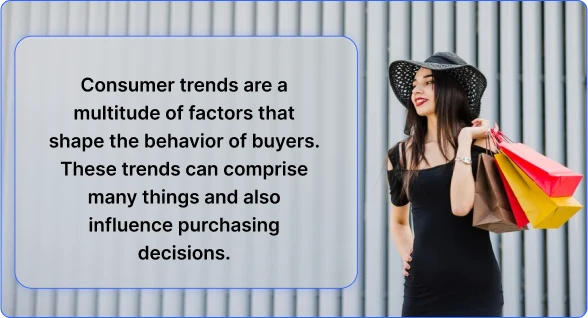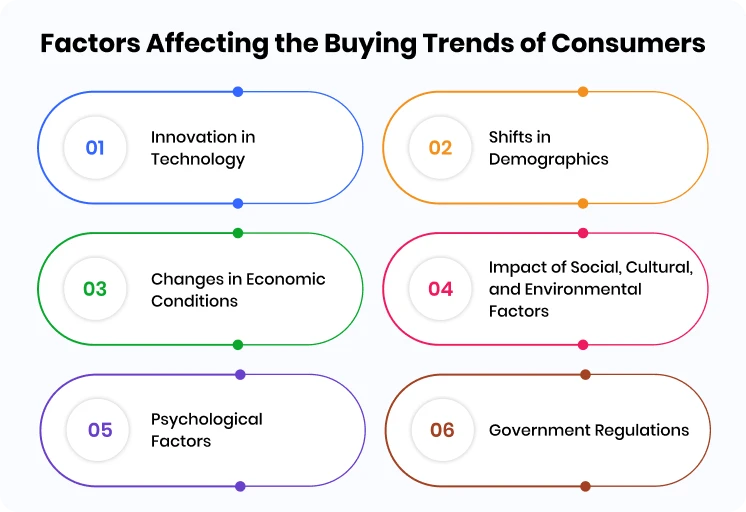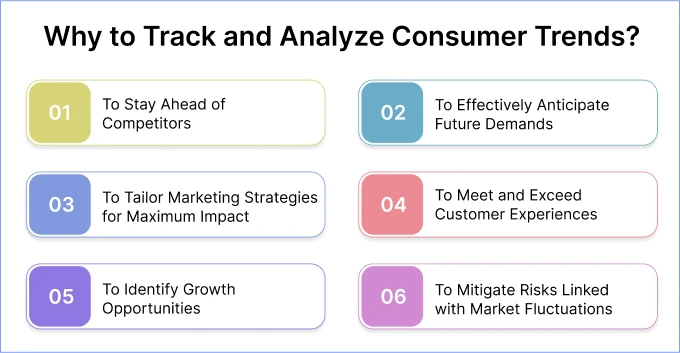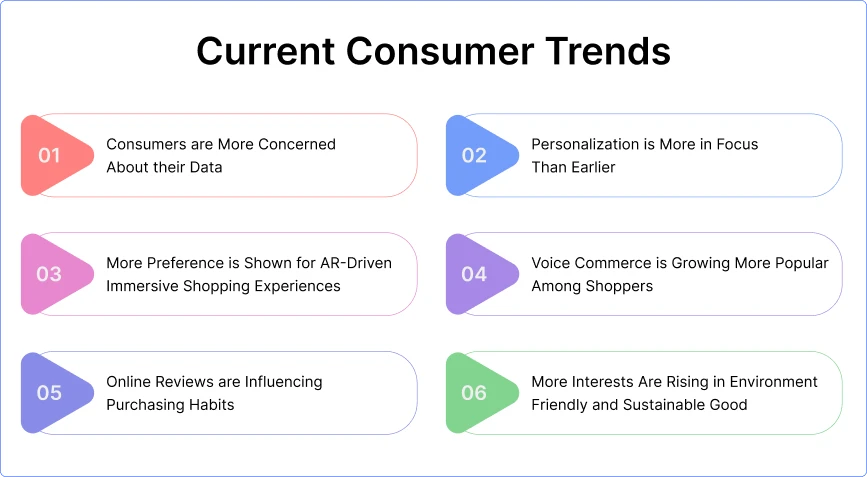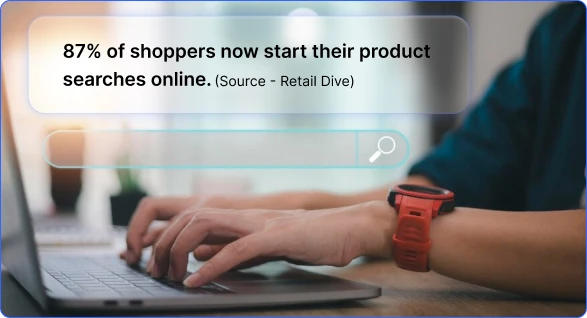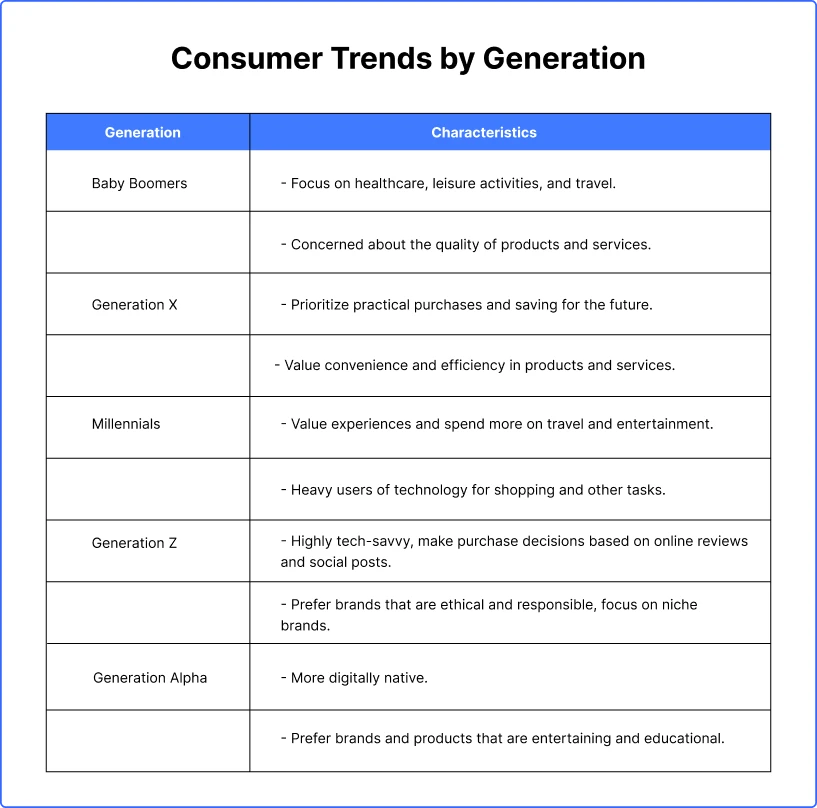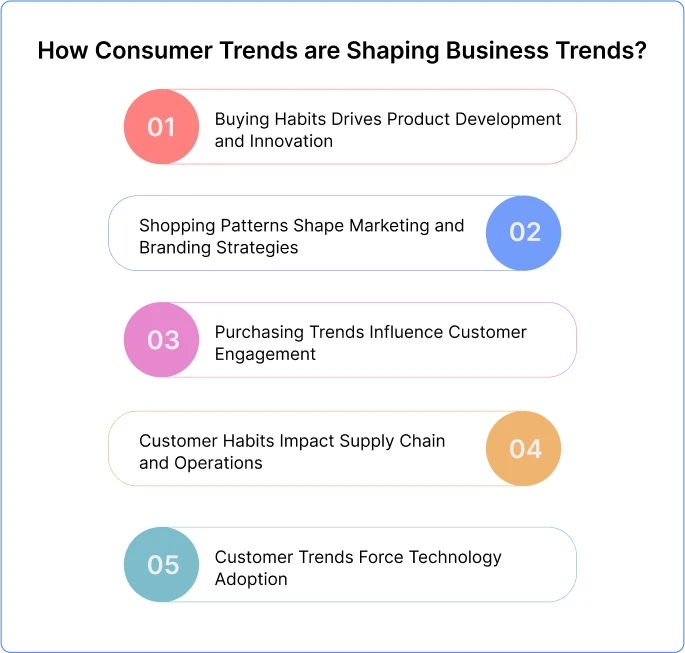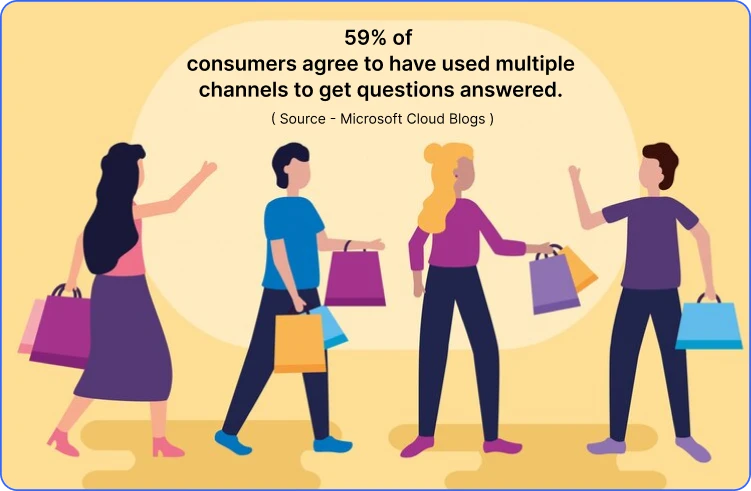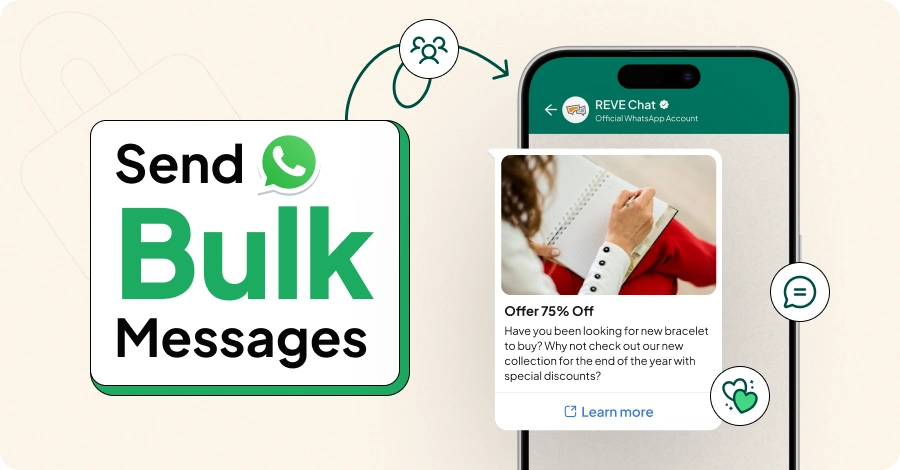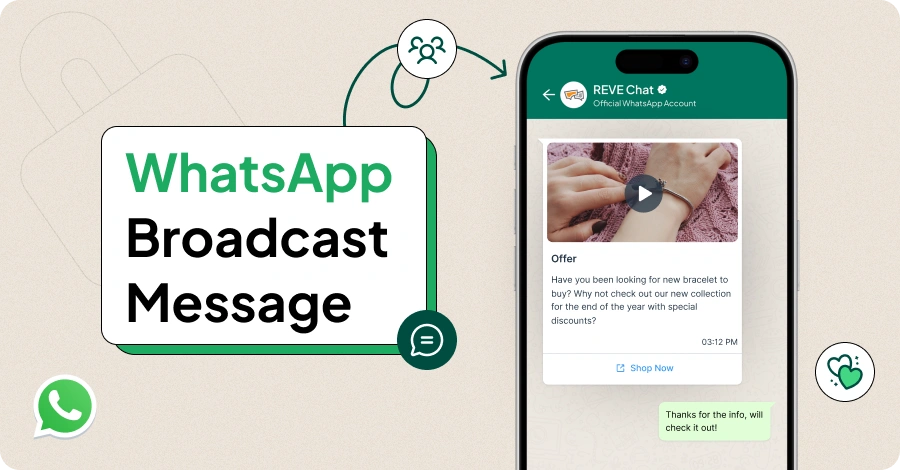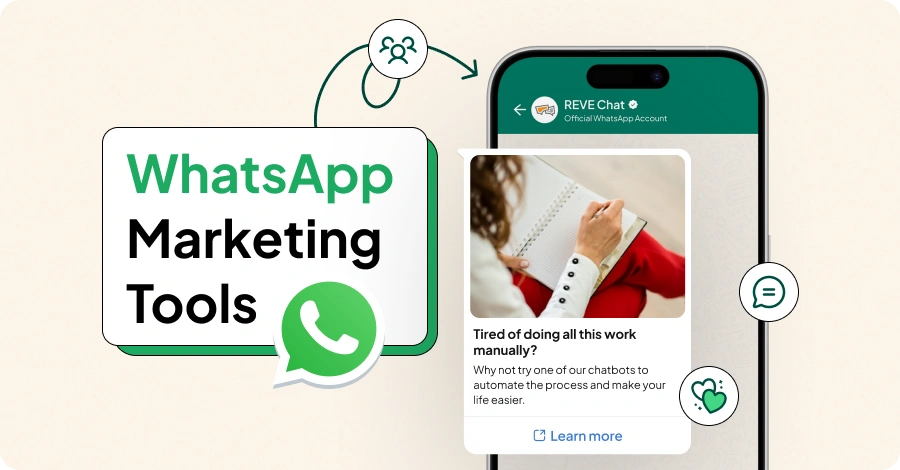Top Consumer Trends to Watch Out for Businesses
- April 22, 2024
- 15 mins read
- Listen

Table of Content
Consumer needs and preferences are constantly changing. From once shopping at physical stores to now browsing products online, a lot has changed in the way buyers approach shopping. More options are available and more avenues are there for shopping. For businesses, the key is to understand consumer trends and stay ahead of the curve.
If a business does not keep an eye on the changing trends around, it might be in danger of falling behind the race. The right approach is to always analyze consumer behavior and see what’s needed by them. When a business is aware of consumer trends, it can always maintain pace with the market forces and stay relevant.
In this blog, we will explore buying trends, understand consumer behavior, and also see some examples behind the shifting trends in the way consumers buy these days.
Before moving further, let’s start with the basics first…
What Are Consumer Trends?
Consumer trends are a multitude of factors that shape the behavior of buyers. These trends can comprise many things, including the changing shifts and preferences in buyers’ approach to shopping. Since these trends influence purchasing decisions, businesses need to understand and analyze the buying motivation of shoppers to maintain relevance and competitiveness in the marketplace.
Take, for example, most of us now prefer to shop online as it brings convenience and ease. However, this was not the case a decade ago as then less people trusted the Internet for shopping. With the explosion of shopping platforms and the rise of e-commerce giants like Amazon, more people prefer online shopping now, marketing a big shift in consumer buying trends.
Factors Affecting the Buying Trends of Consumers
Understanding what drives consumers to buy something is vital for adapting to evolving customer behavior. A business that gains insights into the factors driving consumer behavior can leverage the information and effectively meet the needs of the target audience.
Many factors are responsible for shaping the way consumers buy-
Innovation in Technology – Tech revolutions like the internet, smartphones, social platforms, and web stores once revolutionized shopping. More changes are expected in the coming years due to emerging technologies such as artificial intelligence (AI), virtual reality (VR), and augmented reality (AR).
Shifts in Demographics – Age, income, household structure, and cultural diversity have always been key factors influencing consumer trends. Buying preferences will be different for different demographic groups. This also explains why preferences for older generations and millennials are not the same.
Changes in Economic Conditions – Consumers spend less when the economic conditions of their country are not favorable. They prioritize essential items only during periods of economic instability. On the other hand, people buy more and show no restraint during the boom period.
Impact of Social, Cultural, and Environmental Factors – These days the focus is more on sustainability and wellness. So, buyers spend more on things aligning with these values. It was not the case earlier. Similarly, people care more for the environment now and they prefer brands and products showing eco-conscious traits.
Psychological Factors – More products and marketing experiences these days are designed based on a good understanding of consumer psychology. Factors such as emotions, attitudes, perception, and motivation are leveraged in the delivery of communication and shopping experiences.
Government Regulations – Government policies have a big role in consumer purchasing decisions across industries, mainly in healthcare, food & beverage. Businesses can comply with changes in regulations to easily gain consumer trust and do well.
Why Track and Analyze the Changing Consumer Buying Trends?
A business needs consumer insights to make informed decisions in marketing and sales. Without customer data, no business can stay agile and competitive in today’s dynamic marketplace. Analyzing consumer trends is therefore key to maximizing profitability and fostering sustainable growth.
Here are some of the key reasons your business should constantly track and analyze shifting trends in consumer shopping habits and behavior –
To Stay Ahead of Competitors – A business that knows what consumers want and what their preferences are can quickly adjust its strategies and innovate its offerings, resulting in a competitive edge.
To Effectively Anticipate Future Demands – Can a business anticipate future demand for its products and services without analyzing consuming shopping trends? No, it can’t. Studying the emerging trends in buying behavior is essential for aligning production and marketing efforts.
To Tailor Marketing Strategies for Maximum Impact – A deep analysis of how consumers prefer to shop and what they expect can prepare a business well to successfully meet their needs. Such insights are also essential for tailoring marketing messages for maximum impact.
To Meet and Exceed Customer Experiences – For customers, experience matters more than you’d imagine. If their experience with your brand is not good, they will share it with others, causing negative word of mouth. You however can avoid that by understanding what consumers want and then delivering on those.
To Identify Growth Opportunities – Analyzing consumer trends and their buying preferences can open the window to their likes and dislikes. These findings can be used to develop new products enter new markets, or identify other growth opportunities for the business.
To Mitigate Risks Linked with Market Fluctuations – The market is volatile and it sometimes causes shifts in consumer buying habits. This shows how not analyzing potential disruptions can negatively impact the long-term sustainability of the business. Such risks can be mitigated when a business tracks and analyzes consumer buying behavior.
Current Consumer Trends
Consumer perception and motivations are largely shaped by changes around. The more disruptions the market faces, the more varied buying behavior is seen in the market.
Let’s analyze some of the latest trends exhibited by consumers all over the world –
1. Consumers are More Concerned About Their Data
Consumers are increasingly becoming more aware of the value of their data. They realize the risks of data breaches and understand how vulnerable their private information can be on the web. There is a widespread concern about the way their data is collected, stored, and used.
In addition, consumers also want businesses to be more transparent about data practices. They want greater control over certain data collection activities. Most buyers today also want companies to have robust customer data management and respect their preferences regarding data sharing and privacy.
2. Personalization is More in Focus Than Earlier
Consumers feel happy when marketing messages and products are customized to their specific needs and preferences. It allows them more meaningful and relevant experiences with brands. Higher levels of engagement are also assured when brands adopt a touch of personalization with the service delivery.
Similarly, more customers like personalized options as they align with their interests. When companies adopt a personalized approach to marketing, sales, and support, it shows they value the choices of their target audiences.
3. More Preference is Shown for AR-driven immersive Shopping Experiences
Augmented Reality (AR) is slowly but gradually changing the way people shop. It is also transforming the way buyers interact and engage with digital content. As a truly transformative technology, it allows shoppers to first visualize products in their real-world setting and then make a purchase.
Thanks to AR, buyers get interactive and immersive previews that hugely enhance their shopping experiences. This technology has already revolutionized gaming and entertainment. More companies now look to leverage it to create engaging marketing strategies, and campaigns and encourage active participation.
4. Voice Commerce is Growing More Popular Among Shoppers
Consumers love the convenience and ease that comes with making purchases using voice commands. They can now just speak their orders without having to type them or navigate them. Today, voice commerce being a great example of conversational commerce is seamlessly integrated with smart devices, giving shoppers access to products with voice commands.
What’s more, all the friction points and steps that were once part of online shopping are reduced, making the entire purchase process streamlined. With voice commerce, shopping has become a truly frictionless experience. Plus, there are many other benefits of conversational commerce as well.
5. Online Reviews are Influencing Purchasing Habits
Online reviews have become a top consumer trend with the huge potential to impact purchasing decisions and habits in today’s digital age. They provide social proof for consumers and help in making informed decisions. Since more buyers do online research before making a purchase, these reviews play a key role in this entire research process.
The impact of reviews is not limited to one industry alone as its value is equally strong across the board. The quantity, recency, and relevancy of online reviews have a great say in shaping consumer preferences. They also serve as user-generated content and inform potential buyers a lot.
6. More Interests Are Rising in Environment Friendly and Sustainable Good
Today’s consumers are more aware of the environmental impact of their buying decisions. They are mindful of the issues related to climate change, pollution, and resource depletion. All this has forced them to reconsider their consumption patterns, resulting in more interest in sustainable goods. Needless to say, customer focus has changed a lot in recent years.
Similarly, consumers now trust brands based on whether they practice social responsibility in their business practices. That’s why sustainable products are selling more as safer and healthier alternatives for families. Brands are also focussing on the use of natural, organic, and eco-friendly choices for a healthier lifestyle.
Top Consumer Trends Across Industries
Consumers are very evolved these days. They like to be at the forefront of changes. This is why they are also driving innovation and transformation across diverse industries. Each industry is now striving to meet and exceed customer needs as only this can keep them relevant in the market.
Let’s look at some of the top changes to buying habits across industries –
1. Software as a Service (SaaS)
In the SaaS industry, there is an increased demand for cloud-based solutions as consumers prefer them for their software needs. That’s why cloud-based tools are available for various purposes, from project management to team collaboration, customer relationship management (CRM ) to human resource management, and more.
2. Banking
With more consumers embracing digital banking services and mobile apps, banks have no choice but to invest more in seamless digital experiences through user-friendly interfaces, and intuitive mobile apps. Similarly, people also expect personalized financial services, so banks need to tailor services to specific individual’s needs and preferences. That’s why, customer service in banking has truly been transformed.
3. Retail
Consumers now expect retailers to offer them integrated shopping experiences across channels. This has led to the rise in omnichannel retailing, promising a cohesive shopping journey. Omnichannel strategies are more in focus with the focus to blend different online and off-channels and provide a seamless experience to buyers.
4. Healthcare
Consumers these days want to access medical care from the comfort of their homes. Healthcare providers understand the shifts in attitude caused by the COVID-19 pandemic, so they are investing more in telehealth and remote care services. Virtual care solutions are now an essential aspect of healthcare customer experiences and services to meet the needs of new-age patients.
5. Food & Beverage
Plant-based and alternative foods are more in focus these days as consumers have grown more aware of their lifestyle choices. This has encouraged food companies to meet the demand for healthier food options like plant-based meat alternatives and dairy-free items. Consumers also expect companies to provide information about the ingredients, production methods, and origin of their products.
Consumer Trends by Generation
Brands always strive to try different techniques to appeal to different generations. However, it’s never easy for businesses to successfully target audiences from different age groups. The key is to focus on the distinct buying trends of each generation and then devise customer-driven marketing and sales strategies accordingly.
Let’s look at consumer trends by generation –
Baby Boomers (Born 1946-1964)
- This generation of buyers focuses more on spending on healthcare, leisure activities, and travel.
- For them, the quality of products and services is always a big concern and factor.
- They are less likely to research products or services before buying because they are less tech-savvy compared to other generations.
Generation X (Born 1965-1980)
- This generation focuses more on practical purchases. Saving for the future is also a big priority for them.
- For them, the convenience of products and services matters more.
- They value convenience and efficiency in products and services.
- Unlike baby boomers, this generation is comfortable with technology and may research things before buying.
Millennials (Born 1981-1996)
- This generation values experiences and spends more on travel and entertainment.
- They are heavy users of technology for shopping and other tasks.
- Millennials are willing to pay more for products, services, and experiences that align with their values.
- Brands should focus more on offering them personalized experiences and customization options.
Generation Z (Born 1997-2012)
- The birth of this generation coincides with the digital boom, so they are highly tech-savvy.
- They make purchase decisions based on online reviews and social posts.
- They prefer brands that are ethical and responsible.
- For Generation Z, niche brands are a top focus.
Generation Alpha (Born 2013-Present)
- This generation’s consumer behavior is still emerging.
- They are more digitally native than previous generations.
- This generation shows more preferences for brands and products that are entertaining, and educational.
How Consumer Trends are Shaping Business Trends?
For businesses, meeting the evolving needs and expectations of their target audience is always a top priority. A good understanding of consumer buying habits and preferences is always key to devising effective customer engagement strategies and staying competitive in the market.
Let’s look at how consumer trends are shaping business trends –
Buying Habits Drives Product Development and Innovation
A business needs to keep an eye on how consumer buying preferences change over time. This information is essential for ensuring product development and innovation. More so, knowing consumer behavior is vital for creating offerings that resonate with consumers.
Shopping Patterns Shape Marketing and Branding Strategies
Establishing a better connection with the target audience is only possible when the business understands the shopping trends of its consumers. This information can be used to create messages in tune with consumer’s aspirations and values.
Purchasing Trends Influence Customer Engagement
More customers now prefer personalization and customization. They seek tailored experiences at each stage of the buying journey. This information is important for businesses when they plan for customer engagement. Based on that, it becomes possible to design and deliver experiences across touchpoints.
Customer Habits Impact Supply Chain and Operations
A lot of businesses adjust their supply chain and operation decisions based on customer buying habits. They have to re-strategize every aspect of sourcing, production, and distribution to meet and exceed buyer’s demands. The change in buying habits also forces companies to switch to minimize inventory risks and adopt agile supply chain strategies.
Customer Trends Force Technology Adoption
Changing consumer behavior is the main driving force behind the way businesses are embracing technologies and digital transformation initiatives. It’s also witnessing more investment in tech solutions capable of improving the customer experience.
Current Buying Trends: Key Stats
- 93% of customers will read online reviews before making a purchase. ( Source – Dixa.Com )
- 87% of shoppers now start their product searches online. ( Source – Retail Dive )
- 59% of consumers agree to have used multiple channels to get questions answered. ( Source – Microsoft Cloud Blogs )
- 73% of customers prefer brands that use their data to personalize their experiences. ( Source – Retail TouchPoints )
Consumer Trends Examples
1. Patagonia Catering to Sustainability Consciousness
Consumers are more concerned about the environmental impact of their purchases. More people look to buy sustainable and eco-friendly options. There is also a growing trust among brands that reduce waste and prioritize responsible sourcing. Patagonia is a popular outdoor apparel company that uses recycled materials in their clothes and also promotes fair labor practices. Above all, they are committed to environmental causes and donate a fraction of their sales percentage to that.
2. Amazon Offering Convenience and Seamless Shopping Experiences
Consumers have become very demanding these days as they value convenience and seamless shopping experiences across channels. From frictionless shopping to quick delivery options to personalization recommendations, they want all with online shopping. Amazon is one brand that understands consumer trends better than most and offers all that is needed.
3. Glossier Driving Consumer Engagement and Community Building
Glossier is a beauty and skincare brand with a strong emphasis on building loyal customers through social media engagement and UG content. It encourages customer feedback and also uses real customers in the marketing campaigns. Customers like it for the way it fosters inclusivity and belonging.
4. Nike Delivering Personalization and Customization
In today’s time, consumers crave personalized products and experiences specific to their tastes and needs. Nike is a brand that understands the unique preferences of its target audience and delivers tailored offerings. Its “Nike By You platform” ensures personalized sneaker customization where anyone can choose their shoe color, style, material, etc to meet their own needs.
Final Thoughts
Consumer buying behavior and preferences are constantly evolving and brands that pay attention to these changes can maintain relevance in the market.
At REVE Chat, we understand how engagement is at the heart of understanding consumer trends and ensuring value at each stage of the buying journey.
We have tons of engagement tools that businesses can use to engage and connect with their target audiences better.
With us, you can sign up and check how our tools can add great value to your business.

